- Clone
- MR1 (See other available formats)
- Regulatory Status
- RUO
- Other Names
- CD40 ligand (CD40L), gp39, T-BAM, TRAP, Ly-62, TNFSF5
- Isotype
- Armenian Hamster IgG
- Ave. Rating
- Submit a Review
- Product Citations
- publications
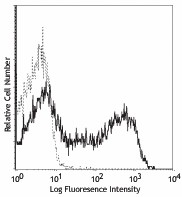
-

PMA- and ionomycin-stimulated (6 hrs) BALB/c T cells stained with MR1 PE.
Select size of product is eligible for a 40% discount! Promotion valid until December 31, 2024. Exclusions apply. To view full promotion terms and conditions or to contact your local BioLegend representative to receive a quote, visit our webpage.
CD154 is a 39 kD TNF superfamily member also known as CD40 ligand, gp39, T-BAM, TRAP, and Ly-62. CD154 is an accessory molecule expressed predominantly on activated CD4+ lymphocytes that bind CD40. CD154 plays an important role in T-B cell costimulation. The MR1 antibody has been reported to inhibit the activation of T and B lymphocytes in vitro and antigen-specific lymphocyte responses in vivo.
Product DetailsProduct Details
- Verified Reactivity
- Mouse
- Antibody Type
- Monoclonal
- Host Species
- Armenian Hamster
- Immunogen
- Activated mouse Th1 clone D1.6
- Formulation
- 0.2 µm filtered in phosphate-buffered solution, pH 7.2, containing no preservative.
- Endotoxin Level
- Less than 0.01 EU/µg of the protein (< 0.001 ng/µg of the protein) as determined by the LAL test.
- Preparation
- The Ultra-LEAF™ (Low Endotoxin, Azide-Free) antibody was purified by affinity chromatography.
- Concentration
- The antibody is bottled at the concentration indicated on the vial, typically between 2 mg/mL and 3 mg/mL. Older lots may have also been bottled at 1 mg/mL. To obtain lot-specific concentration and expiration, please enter the lot number in our Certificate of Analysis online tool.
- Storage & Handling
- The antibody solution should be stored undiluted between 2°C and 8°C. This Ultra-LEAF™ solution contains no preservative; handle under aseptic conditions.
- Application
-
FC - Quality tested
IHC-F, Block - Reported in the literature, not verified in house - Recommended Usage
-
Each lot of this antibody is quality control tested by immunofluorescent staining with flow cytometric analysis. For flow cytometric staining, the suggested use of this reagent is ≤ 0.5 µg per million cells in 100 µl volume. It is recommended that the reagent be titrated for optimal performance for each application.
- Application Notes
-
Additional reported applications (for the relevant formats) include: immunohistochemical staining1,2 of acetone-fixed frozen sections, and in vitro and in vivo blocking of ligand binding3-5. For most successful immunofluorescent staining results, it may be important to maximize signal over background by using a relatively bright fluorochrome-antibody conjugate (Cat. No. 106506) or by using a high sensitivity, three-layer staining technique (e.g., including a biotinylated antibody (Cat. No. 106504) or biotinylated anti-Armenian hamster IgG (Cat. No. 405501) second step, followed by SAv-PE (Cat. No. 405204). The Ultra-LEAF™ purified antibody (Endotoxin <0.1 EU/µg, Azide-Free, 0.2 µm filtered) is recommended for functional assays (Cat. Nos. 106515-106520).
-
Application References
(PubMed link indicates BioLegend citation) -
- Lettesjö H, et al. 2000. J. Immunol. 165:4095. (IHC)
- Dunn RJ, et al. 1997. J. Histochem. Cytochem. 45:129. (IHC)
- Noelle RJ, et al. 1992. P. Natl. Acad. Sci. USA 89:6550. (Block)
- Roy M, et al. 1995. Eur. J. Immunol. 25:596. (Block)
- Foy TM, et al. 1994. J. Exp. Med. 180:157. (Block)
- Lawson BR, et al. 2007. J. Immunol. 178:5366.
- RRID
-
AB_2813947 (BioLegend Cat. No. 106520)
AB_2813947 (BioLegend Cat. No. 106518)
AB_2813947 (BioLegend Cat. No. 106519)
AB_2813947 (BioLegend Cat. No. 106515)
AB_2813947 (BioLegend Cat. No. 106516)
AB_2813947 (BioLegend Cat. No. 106517)
Antigen Details
- Structure
- TNF superfamily, 39 kD
- Distribution
-
Activated CD4+ T cells
- Function
- T-B cell costimulation
- Ligand/Receptor
- CD40
- Cell Type
- T cells, Tregs
- Biology Area
- Costimulatory Molecules, Immunology
- Molecular Family
- Adhesion Molecules, CD Molecules
- Antigen References
-
1. Barclay A, et al. 1997. The Leukocyte Antigen FactsBook Academic Press.
2. Noelle RJ, et al. 1992. P. Natl. Acad. Sci. USA 89:6550.
3. Bancherou J, et al. 1994. Annu. Rev. Immunol. 12:881.
4. Clark EA, et al. 1996. P. Natl. Acad. Sci. USA 83:4494. - Gene ID
- 21947 View all products for this Gene ID
- Specificity (DOES NOT SHOW ON TDS):
- CD154
- Specificity Alt (DOES NOT SHOW ON TDS):
- CD154
- App Abbreviation (DOES NOT SHOW ON TDS):
- FC,IHC-F,Block
- UniProt
- View information about CD154 on UniProt.org
Related FAQs
- Do you guarantee that your antibodies are totally pathogen free?
-
BioLegend does not test for pathogens in-house aside from the GoInVivo™ product line. However, upon request, this can be tested on a custom basis with an outside, independent laboratory.
- Does BioLegend test each Ultra-LEAF™ antibody by functional assay?
-
No, BioLegend does not test Ultra-LEAF™ antibodies by functional assays unless otherwise indicated. Due to the possible complexities and variations of uses of biofunctional antibodies in different assays and because of the large product portfolio, BioLegend does not currently perform functional assays as a routine QC for the antibodies. However, we do provide references in which the antibodies were used for functional assays and we do perform QC to verify the specificity and quality of the antibody based on our strict specification criteria.
- Does BioLegend test each Ultra-LEAF™ antibody for potential pathogens?
-
No, BioLegend does not test for pathogens in-house unless otherwise indicated. However, we can recommend an outside vendor to perform this testing as needed.
- Have you tested this Ultra-LEAF™ antibody for in vivo or in vitro applications?
-
We don't test our antibodies for in vivo or in vitro applications unless otherwise indicated. Depending on the product, the TDS may describe literature supporting usage of a particular product for bioassay. It may be best to further consult the literature to find clone specific information.
Other Formats
View All CD154 Reagents Request Custom Conjugation| Description | Clone | Applications |
|---|---|---|
| Biotin anti-mouse CD154 | MR1 | FC |
| PE anti-mouse CD154 | MR1 | FC |
| APC anti-mouse CD154 | MR1 | FC |
| PE/Cyanine7 anti-mouse CD154 | MR1 | FC |
| PerCP/Cyanine5.5 anti-mouse CD154 | MR1 | FC |
| Ultra-LEAF™ Purified anti-mouse CD154 | MR1 | FC,IHC-F,Block |
Customers Also Purchased
Compare Data Across All Formats
This data display is provided for general comparisons between formats.
Your actual data may vary due to variations in samples, target cells, instruments and their settings, staining conditions, and other factors.
If you need assistance with selecting the best format contact our expert technical support team.
-
Biotin anti-mouse CD154
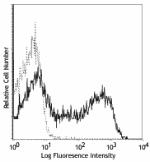
PMA- and ionomycin-stimulated (6 hrs) BALB/c T cells stained... -
PE anti-mouse CD154

PMA- and ionomycin-stimulated (6 hrs) BALB/c T cells stained... -
APC anti-mouse CD154

Enriched C57BL/6 mouse splenic T cells were stimulated with ... -
PE/Cyanine7 anti-mouse CD154
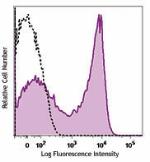
Enriched C57BL/6 mouse splenic T cells were stimulated with ... -
PerCP/Cyanine5.5 anti-mouse CD154
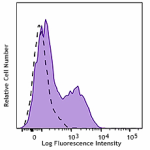
Enriched C57BL/6 mouse splenic T cells were stimulated with ... -
Ultra-LEAF™ Purified anti-mouse CD154

PMA- and ionomycin-stimulated (6 hrs) BALB/c T cells stained...
 Login / Register
Login / Register 







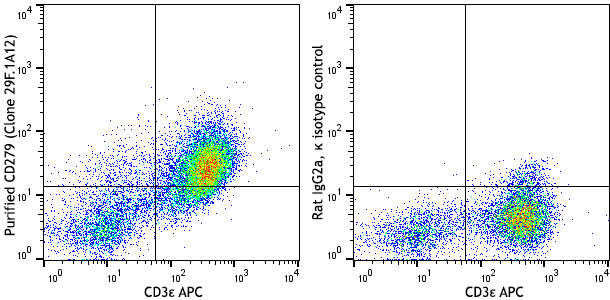

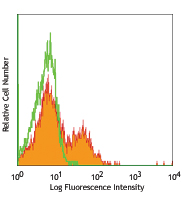



Follow Us